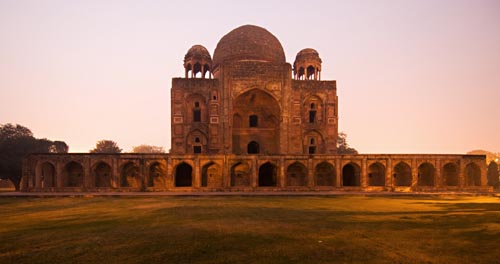Khan-i-Khanan Tomb

Information on Khan-i-Khanan Tomb (New Delhi) - History & Architecture
The Khan-i-Khanan's tomb is also known as the tomb of Abdul Rahim Khan-i-Khanan. It is located on the Mathura road in the area of Nizamuddin,Old Delhi. The mausoleum is situated at a walking distance from the Humayun's tomb. The complex that houses the tomb is quite large and the mausoleum is known to look discarded along with being dilapidated. An initial look is supposed to be enough to decipher the fact that the mausoleum has been ripped of its adornment in time. Abdul Rahim was commonly known by the name of Rahim who was a philosopher as well as a poet in Akbar's court. He was considered one among the Navaratnas or the Nine Gems in Akbar's court.
Khan-i-Khanan Tomb Architecture
The mausoleum was constructed in the year 1598 by Abdul Rahim as a commemorative plaque in the loving memory of his wife but after he died in the year 1627, he himself was also entombed in the similar place. The tomb is square in shape and has been beautifully erected with red coloured sandstone as well as grey coloured Delhi quartzite combined with marble. The mausoleum is regarded as an embodiment of fine craftsmanship and outstanding symmetry. The tomb stands on quite a square shaped lofty platform which gives it a remarkable but strikingly enormous look. The raised platform includes curved compartments that run through all the sides of the plinth and the curved apertures of each of the compartments or chambers are bordered with decorations of diverse and detailed designs. The platform is manifested with numerous small sized tanks in various designs. The decoration within the tomb is notable owing to the presence of engraved decorations along with floral and geometrical prototypes on the point of entrance. Inside the tomb, a sole, huge, unembellished cubical tombstone can be found under which Rahim and his wife was buried. The shadowy grave chamber is known to be marvellously highlighted with work of plaster. One of the most outstanding characteristic of the tomb is the arched roof where a huge spherical shaped medal in the middle can be observed which is further encircled with eight thoroughly positioned smaller medallions.
Khan-i-Khanan Tomb History
Abdul Rahim was not only an eminent poet and a nobleman in Akbar's court but was also the step son of Akbar. Bairam Khan was the father of Abdul Rahim who was the mentor, tutor and guardian of Akbar. Akbar took responsibility of Abdul Rahim after the murder of his father and later got married to Bairam Khan's second wife. Although, Abdul Rahim was a Muslim by religion but he is known to have compiled verses in admiration of Lord Krishna. His work of compilation was greatly admired by his existing competitor and the eminent Sanskrit poet, Tulsidas. Rahim was learnt to have died in Lahore after which he was buried in the mausoleum that he constructed for his wife. The Mughals innovated their architectural pattern with the inclusion of domes, curves and openings for the purpose of making certain that the monuments constructed by them remained significantly cooler in comparison to their surroundings. This particular characteristic can be well observed in the architectural pattern of this tomb. Apart from a few of the alterations, the tomb of Abdul Rahim or Khan-i-Khanan is considered to be an architectural facsimile of the Humayun's tomb.
Khan-i-Khanan Tomb Tourism Significance
Abdul Rahim is quite an eminent and revered Muslim poet whose verses are still included in the curriculum of the Central Board of Secondary Education (CBSE) which makes Khan-i-Khanan a must visit place. The other reason for people visiting the tomb is its proximity to the Humayun's tomb. Therefore, the Khan-i-Khanan attracts quite a large crowd.
- Andaman Nicobar Monuments
- Andhra Pradesh Monuments
- Assam Monuments
- Bihar Monuments
- Chhattisgarh Monuments
- New Delhi Monuments
- Goa Monuments
- Gujarat Monuments
- Haryana Monuments
- Himachal Pradesh Monuments
- Jammu and Kashmir Monuments
- Karnataka Monuments
- Kerala Monuments
- Madhya Pradesh Monuments
- Maharashtra Monuments
- Odisha Monuments
- Punjab Monuments
- Rajasthan Monuments
- Tamil Nadu Monuments
- Telangana Monuments
- Uttar Pradesh Monuments
- West Bengal Monuments